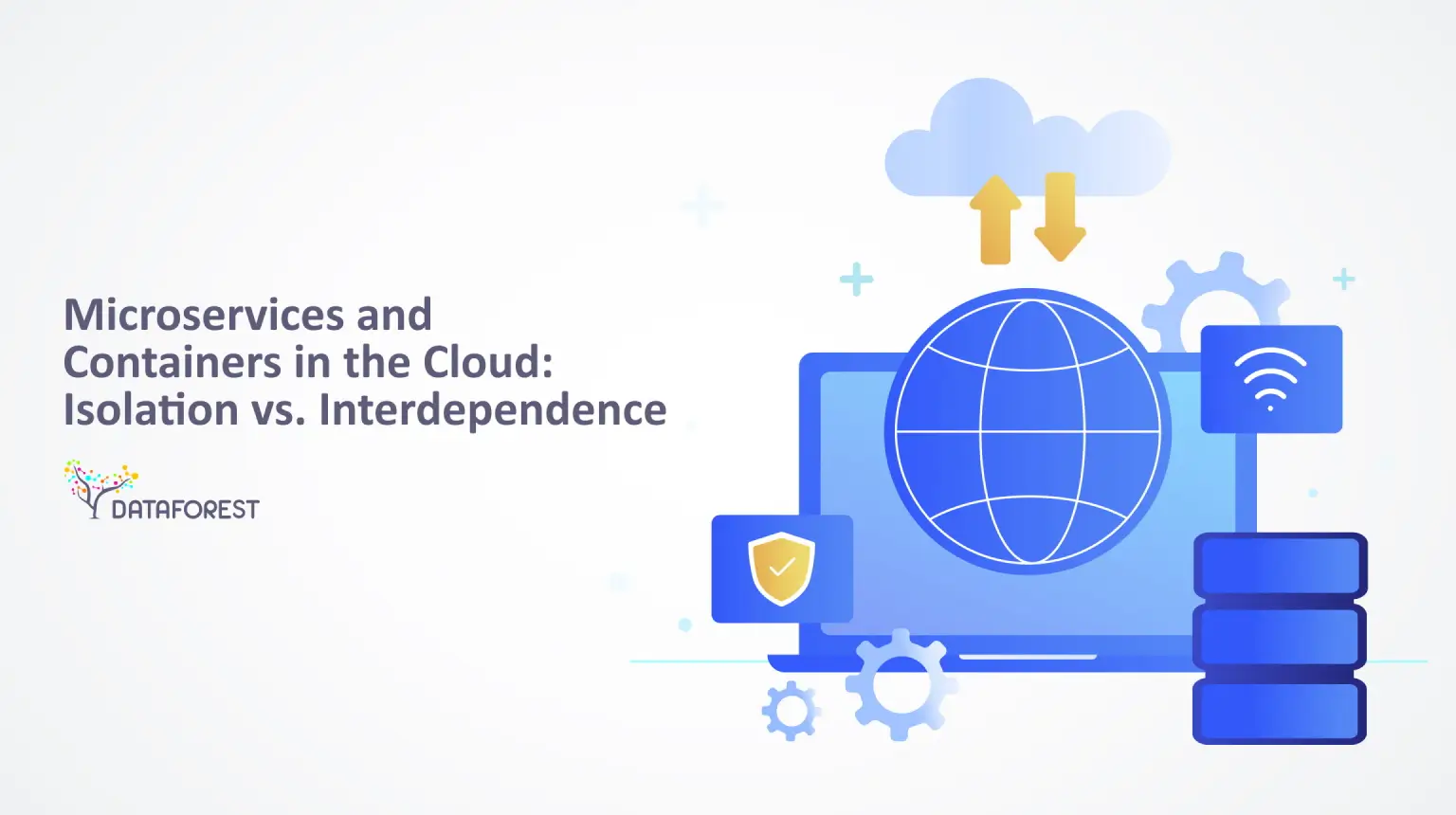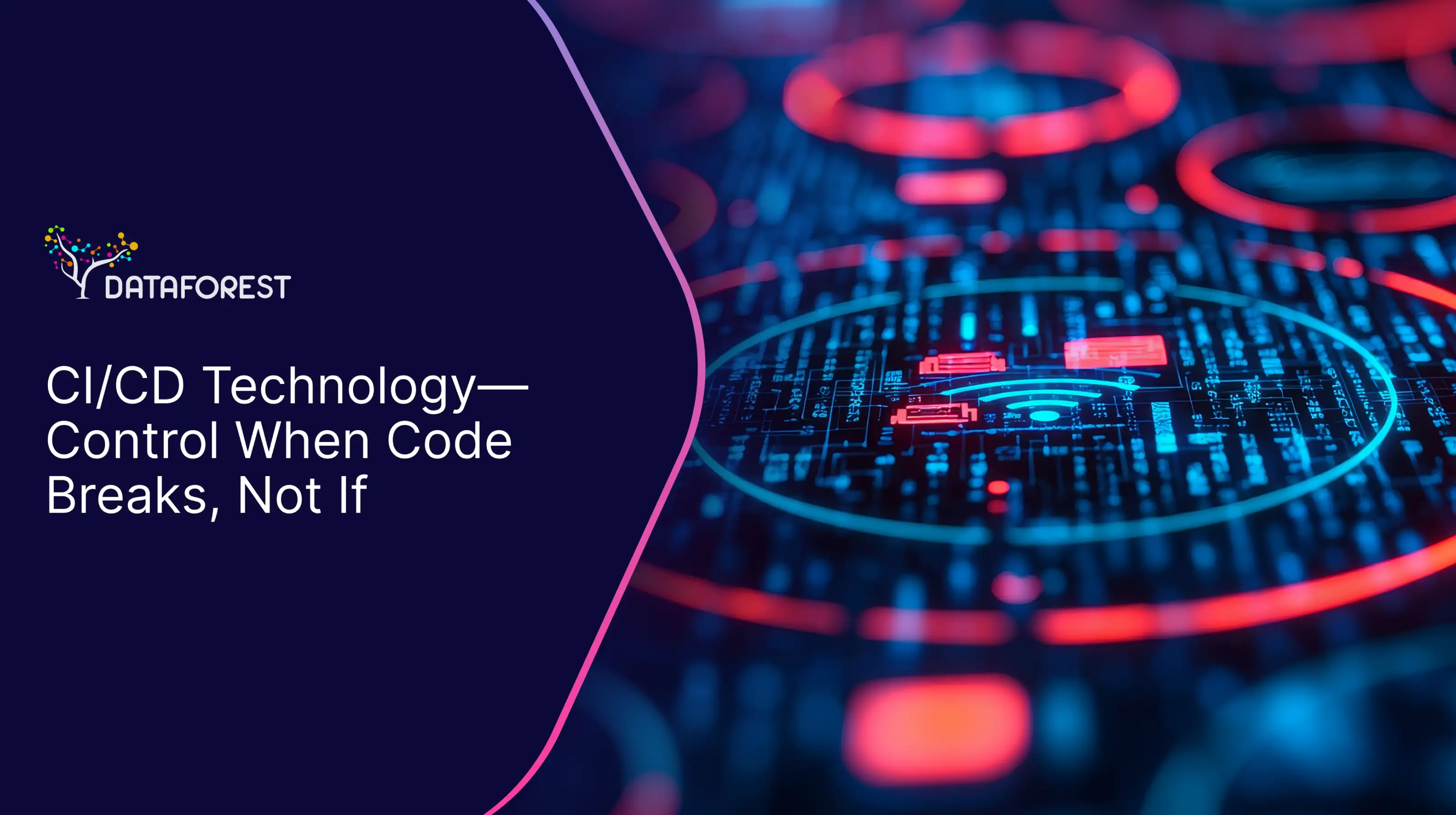Picture each cinema hero having their secret base, totally isolated from the others. That's what containers do: they keep each app and its stuff all tucked away so they don't mess with each other. Superheroes usually work together to tackle significant challenges, right? Similarly, in a microservices setup, these services must collaborate to create a powerful app. But if each one's locked away in its container fortress, how can they talk to each other properly?

Microservices and Containers — The Catch of the Twist
The real trick is finding that sweet spot where you let microservices and containers in a cloud architecture work independently in their containers while also allowing them to chat, share resources, and team up like true heroes. It's like ensuring each hero has their own turf, yet they can still seamlessly join forces. For the same purpose, you can book a call to us.
Cloud Architecture: Agility with Microservices and Containers
The overview of microservices and containers in cloud architecture highlights how these innovative technologies revolutionize application development, deployment, and management within cloud environments.
Microservices and containers in cloud architecture complement each other exceptionally well. Microservices are encapsulated within containers, allowing each service to run in its isolated environment while benefiting from the consistency and portability of containers. This integration results in a highly agile, scalable, and manageable application landscape.
The Power of Microservices and Containers in Cloud Application Development
Using microservices and containers for building scalable and flexible cloud applications is a strategic move that holds immense importance in modern software development. These technologies provide many benefits of using microservices in a cloud-native architecture that aligns perfectly with the dynamic demands of cloud environments.
- Scalability and elasticity
- Modular architecture
- Faster development and deployment
- Fault isolation and resilience
- Resource efficiency
- Flexibility and technology diversity
- DevOps enablement
- Cost optimization
Microservices and Containers in Cloud Architecture: A Deep Dive
This article explores the dynamic landscape of microservices and containers within cloud architecture. It delves into the fundamentals of both concepts, highlighting their distinctions and synergies. The content encompasses a detailed analysis of the benefits of microservices and containers in cloud-native applications, techniques for effective integration, challenges to be addressed, and real-world examples that illustrate their transformative potential.
Microservices and Containers — Navigating the Basics for Cloud Architecture
Imagine you're building a digital LEGO masterpiece. Microservices are like those specific bricks — each has unique functionality and works independently. Now, containers are like these magic transparent boxes holding your LEGO creations, ensuring they don't mess with each other. We're breaking down how these microservices and containers team up to create flexible, powerful cloud applications.
How Microservices Architecture Thrives in Cloud-Native Environments
Microservices architecture requires breaking down applications into smaller, specialized services that handle distinct functions. In cloud-native environments, this approach offers flexibility for rapid updates, efficient scaling based on demand, and fault isolation, ensuring seamless performance and adaptability to dynamic cloud landscapes. This modularity promotes faster development cycles, resilience, and optimized resource utilization, making it an ideal fit for cloud-native applications' agile and evolving nature.
The Power of Containers for Lightweight and Consistent Application Delivery
Containers are digital suitcases that carry everything an application needs to run smoothly, from code to libraries. They create a consistent environment regardless of where the application service is deployed. This lightweight and portable nature of containers simplifies deployment across different stages, from development and testing to production, ensuring applications work the same way everywhere.
Microservices vs. Monolithic Architecture
- Monolithic Architecture:
In the monolithic city, everything is crammed into one giant building. All the shops, homes, and offices share the same space. While it's easy to navigate, any change — even a minor one — requires remodeling the entire building. It's renovating your house and accidentally knocking down the whole neighborhood.
- Microservices Architecture:
Now, picture a city with separate buildings for each purpose: a mall, an office complex, and residential blocks. In this microservices city, each building service does its thing independently. Need to upgrade the mall? No problem; the office complex keeps humming along. It's renovating your house without disturbing your neighbors.
Microservices architecture offers the flexibility to modify individual services without disrupting others, pinpoint scalability for specific components, expedite development teams through concurrent teamwork, fault isolation for contained issues, and the ability to employ diverse technology stacks for optimized functionality.
Microservices vs. Containerization in Modern Application Development
Microservices focus on breaking down applications into modular services, while containerization provides a consistent and isolated environment to efficiently deploy and run these services.
The Symbiotic Relationship Between Microservices and Containerization
Microservices and containerization are the dynamic duo of application development. Microservices are the building blocks of your application, each specialized and independent. Containerization is the protective shield that wraps around these blocks, ensuring they stay organized, isolated, and efficient when deployed. Microservices provide agility and flexibility, while containerization delivers consistency and portability, creating a harmonious partnership that transforms how we build, deploy, and manage apps.
Elevating Microservices: How Containers Forge the Perfect Deployment
Containers provide a seamless environment where these services can shine.
Isolation
Containers act like protective bubbles. Each microservice gets its bubble, free from interference from other services. This isolation ensures that changes or issues in one microservice won't disrupt the playground.
Consistency
Like a playground with consistent rules, containers offer a standardized environment. It means your microservices will work the same way everywhere: from your laptop during development to the cloud computing during deployment.
Portability
Imagine picking up your playground and moving it wherever you want. That's what containers do. They allow you to quickly move your microservices playground across different environments, whether a developer's laptop, testing servers, or production servers.
Resource Efficiency
Containers are incredibly lightweight. They share resources with the host system, making them efficient and avoiding resource wastage. This efficiency is vital when you're running a bunch of microservices.
Scaling
Containers are magic boxes that are cloned with a snap. Need more of a particular microservice? Create more containers. This scaling ability is a dream come true for handling varying loads and spikes in demand.
Management
Picture having a playground where you can watch every kid without running around. Containers offer streamlined management with tools that monitor, automate, and orchestrate your microservices playground.
The Advantages of Containerization
Containerization empowers microservices with isolation, ensuring that issues in one microservice don't disrupt the entire application. It enables precise scalability by allowing individual microservices to be scaled independently based on demand, optimizing resource usage. With rapid deployment, containerization streamlines updates and feature releases, accelerating time-to-market while maintaining consistency across environments.
The Essence of Containerized Microservices Architecture
The containerized microservices architecture is a software design approach where individual microservices are packaged into lightweight, isolated containers, each running as a discrete unit and orchestrated to work together seamlessly, enhancing agility and scalability in application development and deployment.
Architectural Harmony with Containerized Microservices
To container microservices architecture, you must combine the principles of microservices, containerization, orchestration, and various supporting components to create an efficient application infrastructure.
- At the core of the service-oriented architecture are microservices — individual, self-contained components. Each microservice is responsible for a specific business capability or function, and they communicate with each other through well-defined APIs.
- Microservices are encapsulated within containers — lightweight, portable, and consistent environments. Containers package the microservice's code, runtime, libraries, and dependencies, ensuring it runs reliably across various environments.
- To manage and coordinate multiple containers and microservices, orchestration tools like Kubernetes or Docker Swarm are used. They automate deployment, scaling, load balancing, and self-healing, making managing easier.
- Load balancers distribute incoming traffic evenly among multiple instances of a microservice, ensuring high availability and optimal resource utilization.
- In a dynamic containerized environment, services come and go. Service discovery tools help microservices locate and communicate with each other as they scale up or down.
- An API gateway is a central entry point for clients and routes requests to the appropriate microservices. It also handles authentication, rate limiting, and request/response transformations.
- Microservices often need access to databases or other data stores. Containers can include database instances or connect to external data storage solutions.
- Effective logging and monitoring tools are crucial for maintaining containerized microservices. They provide insights into the health of individual services.
- Security measures like container image scanning, network segmentation, and role-based access control are essential to protect containerized microservices from threats.
- Continuous Integration and Continuous Deployment (CI/CD) pipelines automate containerized microservices' build, testing, and deployment.
- Containers and orchestration tools make it easy to scale individual microservices horizontally by adding or removing instances based on demand.
- Containers enable version control, allowing multiple versions of a microservice to coexist and be managed independently.
Containerized Microservices: Best Practices for Development and Deployment
You can successfully develop and deploy containerized microservices that are scalable, maintainable, and well-suited for modern cloud-native environments.
- Begin with a well-defined strategy and purpose for each microservice.
- Keep containers lightweight by using a minimal base image.
- Design microservices to be stateless, independent, and single-purpose.
- Establish clear API contracts for microservices using OpenAPI or Swagger.
- Use databases for each service or implement data sharing through well-defined APIs.
- Employ orchestration tools (Kubernetes or Docker Swarm) for automated management.
- Use discovery mechanisms to enable dynamic communication between microservices.
- Apply load balancers to distribute incoming traffic among microservice instances.
- Use logging and monitoring solutions to gain insights into microservice health.
- Security: RBAC, network policies, image scanning, and secrets management.
- Establish CI/CD pipelines to build, test, and deploy containerized microservices.
- Version control container images and store them in a registry for traceability.
- Ensure development, testing, and production environments closely resemble each other.
- Treat infrastructure and containers as immutable, replacing them with new versions.
- Define scaling strategies based on CPU, memory, and custom metrics.
- Develop disaster recovery and backup strategies to safeguard data and services.
- Maintain comprehensive documentation for each microservice.
- Conduct testing to ensure that containerized microservices meet expected standards.
- Regularly review and optimize containerized microservices to identify bottlenecks.
Microservices Potential — Containers as Catalysts
Containers are the backbone of service isolation, flexibility, and scalability in microservices architecture through their unique characteristics.
Service Isolation
Containers encapsulate microservices along with their dependencies, isolating them from each other. Each microservice runs in its container, ensuring that changes or issues in one service do not affect others. It's like providing individual rooms for each guest in a hotel to prevent disruptions.
Flexibility
Containers allow microservices to be modular and independently deployable. You can update, replace, or scale individual microservices without affecting the entire single application. This flexibility enables agility in software development, much like swapping out LEGO pieces to modify a creation.
Scalability
Containers make it easy to scale microservices horizontally by adding more container instances. You can allocate additional resources to specific microservices that experience increased demand while leaving others unaffected. It's similar to extending a road to accommodate more traffic on a busy street without altering the entire city's infrastructure.
Efficient Resource Utilization
Containers share the host operating system's kernel, making them lightweight and resource-efficient. This shared resource model ensures optimal utilization of available resources, akin to sharing tools within a workshop to accomplish various tasks efficiently.
Consistency
Containers provide consistent environments across different stages, from development to production. This consistency reduces the "it works on my machine" problem, ensuring that microservices behave predictably, like using standardized blueprints to construct identical houses in a neighborhood.

Harnessing the Benefits of Microservices for Modern Applications
Using microservices in a cloud-native architecture offers scalability, agility, fault tolerance, and resource efficiency, enabling teams to deliver and maintain modern, cloud-based applications efficiently.
The Advantages of Microservices in a Cloud Architecture
These groupings highlight how microservices, when integrated into a cloud-native software architecture, offer a range of benefits of using microservices in a cloud-native architecture that collectively enhance the efficiency, resilience, and agility of modern applications.
Book a call, get advice from DATAFOREST, and move in the right direction.
Microservices in Dynamic Cloud Environments
Microservices excel in scalability and elasticity within dynamic cloud environments. They allow for precise scaling of individual services based on demand, ensuring optimal resource allocation and cost-efficiency. This granular scalability enhances the ability to respond quickly to varying workloads and traffic spikes while maintaining overall system performance and responsiveness.
Microservices' Fault Isolation, Independent Deployment, and Continuous Delivery
Improved fault isolation in microservices ensures that if one component encounters issues, it doesn't disrupt the entire app, enhancing system resilience. The deployment empowers each microservice to be updated, scaled, or rolled back independently, reducing deployment risks and enabling faster feature releases. These capabilities align seamlessly with continuous delivery practices, facilitating swift, automated, and reliable software delivery.
Techniques for Microservices and Containers in Cloud Environments
Techniques for using microservices and containers in cloud architecture emerged as a response to the need for scalable, flexible, and efficient methods to design, deploy, and manage modern applications.
Designing Microservices with Containers in the Cloud
Designing and implementing microservices using containers in the cloud involves various techniques to optimize development, deployment, and management. Here are top-5:
- Break down your application into small, focused microservices that align with specific business capabilities. This decomposition simplifies development and maintenance.
- Use container technology like Docker to package each microservice and its dependencies into a single, portable unit.
- Employ container orchestration tools like Kubernetes to automate the deployment, scaling, load balancing, and monitoring of containerized microservices.
- Implement service discovery mechanisms that allow microservices to locate and communicate with each other dynamically. Tools like Consul can assist in this.
- Utilize an API gateway to manage requests to your microservices. It is a central entry point, handling authentication, routing, and request/response transformations.
Kubernetes and Beyond: Orchestrating Containerized Microservices
Container orchestration platforms such as Kubernetes are powerful tools for managing containerized microservices by automating deployment, scaling, and resource management, streamlining service discovery, health monitoring, self-healing, and facilitating rolling updates and rollbacks. They enable efficient configuration management and fault tolerance while offering extensibility and support for multi-cloud and hybrid cloud environments, making them essential for maintaining resilient, highly available, and adaptable microservices architectures in modern cloud-native landscapes.
Strategies for Efficient Communication, Load Balancing, and Fault Tolerance
Efficient communication, load balancing, and fault tolerance are critical aspects of a robust microservices architecture.
Efficient Communication
- Implement RESTful APIs for communication between microservices. This standardized approach simplifies integration and enables loose coupling between services.
- Use message queues like RabbitMQ or Apache Kafka for asynchronous communication when real-time interactions are unnecessary.
- Consider gRPC, a high-performance, open-source framework for remote procedure calls. It allows for efficient communication between microservices through protocol.
Load Balancing
- Implement load balancers at the entry point to your microservices architecture. These distribute incoming requests evenly among service instances.
- Utilize dynamic load balancers that adapt to changing traffic patterns and automatically adjust routing based on the availability of service instances.
- Use service discovery mechanisms, like Consul or Kubernetes' built-in service discovery, in combination with load balancers.
- Consider using external load balancers provided by cloud providers or dedicated load balancing services like AWS Elastic Load Balancing or Azure Load Balancer.
Fault Tolerance
- Implement the Circuit Breaker pattern to prevent cascading failures. It temporarily blocks requests to a microservice if it's experiencing issues.
- Employ retry mechanisms in clients to handle transient failures. These retries can be configured with exponential backoff to avoid overloading struggling services.
- Set appropriate timeouts for requests to microservices. If a response is not received in time, the client takes appropriate action, such as retrying or returning an error.
- Apply the Bulkhead pattern to isolate parts of your system. It limits the impact of failures in one part of the application on other components.
- Regularly conduct chaos engineering experiments to proactively identify and address weaknesses in your microservices architecture, making it more resilient to failures.
These strategies collectively ensure efficient communication, load balancing, and fault tolerance in a microservices architecture.
Considerations in Microservices and Containers in Cloud Architectures
Challenges and considerations when working with microservices and containers in cloud architecture include managing complexity, ensuring security and compliance, implementing effective monitoring and logging, optimizing resource utilization, and addressing communication and data consistency challenges between microservices.
Mastering Microservices and Containers: Navigating Challenges and Considerations
Navigating these challenges and considerations requires careful planning, ongoing evaluation, and a commitment to best practices in microservices and containerized cloud architectures.
Optimizing Performance and Reliability
Monitoring, logging, and troubleshooting are essential for managing distributed microservices environments.
Monitoring
- Monitoring involves observing the performance of microservices in real time.
- Metrics like response times, error rates, resource utilization, and throughput are monitored to ensure that microservices are operating as expected.
- Monitoring tools such as Prometheus, Grafana, and Datadog are used to collect and visualize data from microservices.
- Automated alerting mechanisms are set up to notify teams when predefined thresholds or anomalies are detected, allowing for proactive issue resolution.
Logging
- Logging is the practice of recording events, errors, and activities within microservices for diagnostic and auditing purposes.
- Microservices generate logs for various purposes, including access, error, and application logs.
- Logs are often aggregated and stored in a centralized location or logging system, such as the ELK (Elasticsearch, Logstash, Kibana) stack or Fluentd.
- Some microservices use structured logging, which formats log entries in a standardized way to facilitate parsing and analysis.
Troubleshooting
- Troubleshooting means identifying and resolving issues affecting microservices' functionality or performance.
- It typically follows a systematic process: identifying the problem, gathering information through logs and monitoring data, isolating the root cause, and implementing a solution.
- Distributed tracing tools like Zipkin or Jaeger are used to trace requests as they flow through multiple microservices, making it easier to pinpoint bottlenecks.
- A/B testing or canary releases are used as troubleshooting techniques to compare the behavior of different versions of a microservice in a controlled manner.
Security and Data Management in Containerized Microservices
- Security: Ensuring containers are regularly patched and hardened, implementing role-based access control (RBAC) and network policies, scanning container images for vulnerabilities, and managing secrets securely is paramount.
- Data Management: Strategies for handling data in microservices include maintaining data consistency and synchronization across distributed services, utilizing databases designed for microservices (e.g., NoSQL databases), and implementing data encryption.
- Compliance: Companies must adhere to regulatory and compliance requirements (e.g., GDPR, HIPAA) when handling data in microservices, which may necessitate data anonymization, auditing, and rigorous access controls.
Use Cases and Examples of Containerized Microservices in Action
Real-world use cases and examples of containerized microservices were formed through practical implementations by teams across various industries, demonstrating the effectiveness of this architectural approach in solving specific business challenges and delivering tangible benefits.
Watch on Netflix: Real-World Stories of Microservices and Containers
Here are some real-world use cases and success stories of companies implementing microservices and containers in cloud architecture:
- Netflix migrated from a monolithic architecture to a microservices-based one. They employ containerization with tools like Docker and orchestrate containers using Titus (Netflix's container management platform) and Kubernetes. This transformation has made it easier for Netflix to manage its vast catalog of movies and TV shows, optimize resource allocation, and maintain high availability for its streaming service.
- Uber uses microservices and containers to power its ride-hailing platform. Containers enable them to deploy and scale services like UberEATS and UberPOOL independently. Kubernetes manages its containerized applications across a hybrid cloud infrastructure, providing flexibility and efficiency as it expands globally.
- Starbucks uses containerization and microservices to enhance its mobile ordering system. Containers provide flexibility and scalability, allowing Starbucks to handle increased demand during peak hours. Kubernetes orchestrates the containerized microservices, ensuring the reliability of the ordering and payment process.
- AWS itself employs containerization and microservices to deliver its cloud services. AWS Fargate, a serverless compute engine for containers, simplifies container deployment and management for customers. AWS also offers services like Amazon EKS, making running containerized microservices on the cloud platform easier.
How Microservices and Containers Drive Innovation
These examples illustrate the versatility of microservices and containers, which can be applied across various industries to enhance digital experiences, improve operational efficiency, and effectively respond to changing customer demands.
Customized Microservices and Containers for Industry-Specific Needs
As a company with extensive experience in microservices and containers in cloud architecture, DATAFOREST offers customized solutions in microservices and containerized architectures that solve immediate challenges and align with the client's industry, business goals, and long-term vision. This approach ensures that clients receive maximum value from their investment in microservices and containers in the context of cloud architecture. If you are ready to use our services, please complete the form, and let's start cooperating.
FAQ
What is the relationship between microservices and containers in cloud architecture?
Microservices and containers have a symbiotic relationship in cloud architecture, where containers provide the lightweight and portable infrastructure to deploy, manage, and scale microservices efficiently.
How do containers facilitate the deployment and management of microservices in the cloud?
Containers facilitate the deployment and management of microservices in the cloud by providing a lightweight, consistent, and isolated environment that packages both the microservice and its dependencies, ensuring seamless deployment across different cloud platforms, efficient resource utilization, and simplified scaling and orchestration through tools like Kubernetes.
How do microservices and containers enable scalability and flexibility in cloud applications?
Microservices and containers enable scalability and flexibility in cloud applications by breaking down applications into modular components that can be independently scaled and deployed within isolated, portable containers.
What are the advantages of containerization for developing and deploying microservices?
Containerization streamlines the development and deployment of microservices by packaging each service and its dependencies into portable, isolated containers, ensuring consistency, ease of deployment, and efficient resource utilization.
What security considerations should be considered when using containerized microservices in the cloud?
Security considerations when using containerized microservices in the cloud include securing container images, implementing access controls, managing secrets, addressing vulnerabilities, and monitoring and auditing for compliance and potential threats.
Can you provide examples of industries or applications successfully implementing microservices and containers in the cloud?
Industries and applications such as e-commerce platforms, video streaming services, financial institutions, healthcare systems, and logistics companies have successfully implemented microservices and containers in the cloud to enhance scalability, agility, and efficiency.
What is the difference between microservices and containers?
Microservices refer to a software architectural style that decomposes applications into small, independent services, while containers are a technology that packages applications and their dependencies for consistent deployment and runtime isolation.









.webp)















